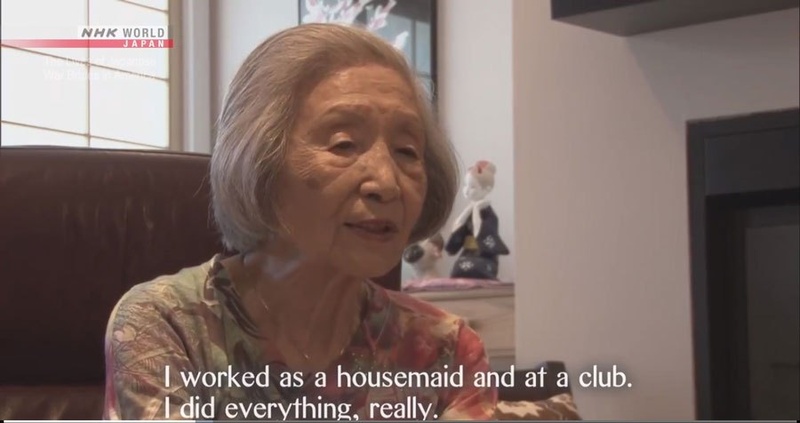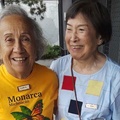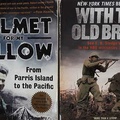Fujie Yamasaki is a person who many readers know. For many years, she was a regular presence at the Seattle Cherry Blossom Festival. Until recently, she also routinely volunteered at Keiro Northwest. She is just one of those people whom many can mentally picture as the “lady with her hair tied up in a kerchief, wearing an apron,” quietly doing meaningful, kind things. She comes across as an ordinary, nice mom who goes by her first name.
Yet, beneath her placid exterior, Fujie has a backstory. A first glimpse into it comes from the two-part NHK World documentary, The Lives of Japanese War Brides in America, broadcast internationally in English in October 2019. The series was featured in the recent “Tadaima! Community Virtual Pilgrimage” film series.
From NHK, we learn that Fujie was a 14-year old kid in the Fukagawa district of Tokyo on the night of its firebombing on March 9-10, 1945. This is telling, for just as present-day readers learned on 9/11, and from the March 2011 Tohoku earthquake and tsunami, sometimes life outcomes turn on exactly where one is on a historic day.
Firebombing
During World War II, conventional bombing—with bombs that explode on impact—reached its limits during the protracted war. It was hard for pilots to hit remaining military targets, such as factories. Thus, by early 1945, US planners changed tactics. Instead of continuing to drop ordinary bombs, they began raining down large numbers of smaller incendiary bombs, filled with flammable napalm, that start fires.
The bombing of Dresden, Germany, in February 1945 is the landmark example of incendiary bombing in Europe. There, 18,000-25,000 people died from it.
Firebombing worked even better in Japan, where houses were largely made of wood and paper. Yet the strategy remains controversial, for it targets civilians.
Fukagawa
Fukagawa is not a place that Americans know, as it lacks major tourist destinations. It lies just off the eastern edge of tourist maps of central Tokyo. The Sumida River traverses this eastern Tokyo hinterland, from northeast to southwest. Fukagawa lies on the east bank of the Sumida River.
Fukagawa is known historically for three reasons. First, in the early 1680s, it was the home of the poet Basho. He lived there to escape the hubbub of Edo, the great growing city that lay west of the Sumida River. It was in serene Fukagawa that he set down his famous frog haiku.
Furu ike ya
Kawazu tobikomu
Mizu no otoThe ancient pond
A frog leaps in
The sound of water
(translation, Donald Keene)
It is also from Fukagawa that Basho sets out on his famous road-trip, Oku no Hosomichi [The Narrow Road to Oku], in the spring of 1684: “The months and days are the travelers of eternity. The years that come and go are also voyages. Those who float away their lives on ships or who grow old leading horses are forever journeying…”
Second, in the early 1830s, woodblock artist Katsushika Hokusai included Fukagawa’s Mannen Bridge in his famous set of woodblock prints, Thirty-Six Views of Mount Fuji. Mannen is Japanese for 10,000 years.
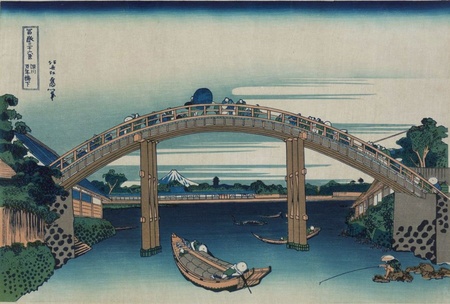
Third, during WWII, US military planners recognized that the densely populated, working-class neighborhoods adjoining the Sumida River were tinderboxes. They were thus targeted specifically.
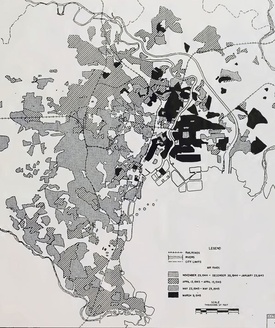
Fukagawa was near the heart of the area blackened by the March firebombing (map). Some 100,000 died. It was the deadliest bombing of the war, surpassing that of the atomic bombings of Hiroshima (70,000-80,000) and Nagasaki (39,000-80,000).
With this background then, we turn to details of Fujie’s story. They draw from the 2019 NHK documentary, emails with daughter Hannah, and a three-way conversation between Fujie, Hannah, and the North American Post in a mixture of Japanese and English.
Escaping the Flames
After the March 10th bombing started, young Fujie began running with her grandmother, who took care of her. But in the frenzy, Fujie lost her grandma, whom she would never see again.
Fujie’s hair caught fire.
“Someone threw her in the river, probably saving her life, Hannah comments. “She woke up to a river filled with bodies.”
After the fire, it wasn’t possible for Fujie to continue her education. She simply went to work, taking any job she could find.
Post-War Life
After the war, Fujie had the good luck to meet Kazuo H. Yamasaki, a Seattle Nisei, in 1952, at a gathering for Nisei. During the day, she worked at a paper company. She moonlighted at a nightclub.
Mr. Yamasaki was in Tokyo, as a civilian, working for the Office of Strategic Services (OSS). The OSS was the precursor to the Central Intelligence Agency (CIA). He interrogated people from North Korea.
Kazuo’s start in that line of work began with his training at the US Army Military Intelligence Service (MIS) School at Fort Snelling, Minnesota. There, the men improved their home-learned Japanese and learned military Japanese. The MIS registry lists Kazuo in the class of [19]45-07. After completing his training, he was assigned to the Headquarters Company of the Military Intelligence School, before apparently shipping overseas.
The MIS-trained Nisei men served in the Korean War (June 1950-June 1953), in addition to their better-known service during WWII and in the Occupation of Japan (1945-Apr. 1952). Korea had been a Japanese colony since 1910, and Japanese was its official language until 1945. Thus, Koreans of that era also spoke Japanese.
In Seattle, the Yamasakis would raise three children, together with their half-brother (who has since passed away). Across the years, Fujie did various jobs including waitressing and working for Seattle Central Community College. Sadly, Kazuo also passed early, at age 77, in 1994.
As described by the NHK (2019), it took two decades for Japanese “war brides” in Seattle to begin being accepted by local Issei and Nisei. The Issei were from the country, while the war brides were middle-class, city girls. Additionally, the Japanese Americans suspected the backgrounds of the new arrivals. What kinds of families would let their daughters marry Americans?
“They didn’t invite us to community gatherings,” Fujie says frankly, in the NHK documentary. What most JAs failed to grasp at the time was the big picture. The Japanese brides were coming from a country that was on the brink of starvation, and where 2 million men—the age peers of the brides—had died in the war. Today, by internet we can see historical street scenes of hungry, crying Japanese children approaching the well-fed, well-dressed, US Occupation soldiers with beseeching arms at every opportunity. One example is the documentary, Tokyo Black Hole (1945-1946), NHK World, 2017.
Moreover, the women who came were the bright, plucky ones who managed to find jobs on or near US military bases, where the pay was 2-3 times that in adjoining Japanese society. They were the ones that managed to learn some English.
In Seattle, the acceptance turning point was when the Issei began entering nursing homes, and needed Japanese-speaking caregivers and volunteers to help them. “We sang to them in Japanese,” Fujie says in the 2019 documentary.
Further acceptance of the Japanese war brides came from the participation of many in the Seattle Cherry Blossom Festival as volunteers. Most Nisei knew little of Japan, so were of limited help to the festival.
Today, Fujie Yamasaki’s life story is a picture of triumph over adversity. She defines the adages, “Life is not what happens to you“ and “Life is what you make of it.”
“With only a junior high education, she came to the US, learned English, and made lots of friends,” Hannah says.
“I couldn’t do it (the reverse trip). I lived in Japan, but I came back.”
* * * * *
Excerpts of the Interview with Fujie Yamasaki
NAP: You lived in Fukagawa, east of the Sumida River?
Fujie: Yes.
NAP: Where, exactly?
Fujie: Hirakawa-cho. My home was walking distance from Kiyosumi Park and the (present-day) Fukagawa Edo Museum. (The latter is 2.4 km south of the better known Edo-Tokyo Museum, near Ryogoku station.)
NAP: Who in your family survived the bombing?
Hannah: Her mother survived. Her father passed when she was a child. Both her older brothers survived the war. The oldest was in China in the Japanese army.
NAP: Fujie was always helping at the Cherry Blossom Festival.
Hannah: She mainly fed the festival volunteers. Without this volunteer support, it would have been hard for the festival to find volunteers.
NAP: What language do the two of you speak at home?
Hannah: English, with Japanese mixed in.
NAP: Jeannie Tsutakawa (wife of musician Deems) tells a funny story, in which Fujie’s mother didn’t think much of Kazuo, until he brought her a case of Johnny Walker Black Label whiskey. Is it true?
Fujie, with daughter Hannah: Yes.
* * * * *
NHK World: The Lives of Japanese War Brides in America (2019)
The two-part English-language series (50 min. and 49 min.) is available for viewing free by streaming on-demand only until early October 2020. It describes the broad story of how 40,000 Japanese brides came to live in the U.S. It includes the narratives of several Seattle-area brides. (Part 1 & Part 2)
NHK WORLD-JAPAN is an international network service provided by NHK, Japan’s sole public broadcaster. In Seattle, you can watch NHK WORLD-JAPAN through Comcast/Xfinity, channel 115, or on local PBS affiliate KBTC, channels 15.2 and 28.2. You can also connect through ROKU, Apple TV, and Amazon Fire TV.
* * * * *
Sources:
NHK World, 2012, “The Great Tokyo Air Raids.”
Oshiro, Seiki; Paul Tani; Grant Ichikawa. Military Intelligence Service Language School Registry 1941-46.
Further Study:
Craft, Lucy; Karen Kasmauski, and Kathryn Tolbert, 2015, Fall Seven Times, Get Up Eight, (26 min.).
This complementary video tells the story of three Japanese war brides and their daughters in the interior of the US. It is available for streaming on Vimeo ($3).
Kaori Hayashi, Keiko Tamura, Fumiko Takatsu, 2002, Senso hanayome: kokkyo o koeta onnatachi no hanseiki = War brides. Fuyo Shobo, Tokyo.
The worldcat site lists this title, which includes content on Fujie Yamasaki, as available for purchase online from AbeBooks.com ($43). It is also at the UW library
© 2020 David Yamaguchi / The North American Post


